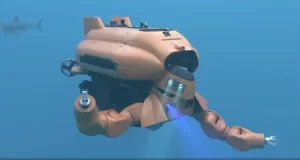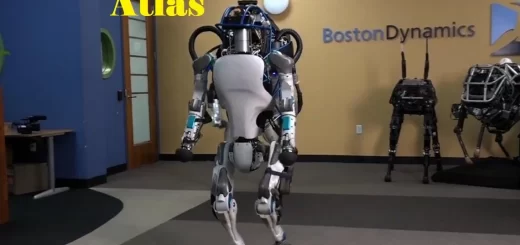Top Trending topics on ocean robots and what are the names of ocean robots?
Ocean robots can collect large amounts of data on water quality, temperature, salinity, and marine life, providing valuable insights for research and conservation. Ocean robots can be more cost-efficient for certain tasks than manned expeditions, especially in remote or challenging locations. Ocean robots offer a powerful tool for exploring, understanding, and protecting the vast underwater world.
Ocean robots
Ocean robots come in various shapes and sizes, They are known as underwater vehicles (UUVs) or submersibles, The term “ocean robot” encompasses a wide range of fascinating machines designed to explore, analyze, and work within the depths of the ocean.
Ocean robots can collect data or perform tasks for longer than human divers could, such as the deep-diving Alvin or the agile OceanOne humanoid robot. Ocean robots are used for many purposes such as scientific research, environmental monitoring, underwater exploration, and maintenance of offshore infrastructure.
Ocean robot examples
Autonomous Underwater Vehicles (AUVs) operate independently, They are self-guided robots, that follow pre-programmed instructions or adapt to their environment. They can collect data, navigate complex terrain, and perform tasks like mapping the seafloor or monitoring water quality.
Remotely Operated Vehicles (ROVs) are controlled by humans from onboard a ship, They can perform a wide range of tasks, from inspection to manipulation. ROVs offer precise maneuverability and agility for tasks like inspection, repair, and scientific sampling, They have cameras, manipulators, and specialized tools for specific missions.
Underwater Gliders are sleek, winged robots, They use buoyancy changes to glide effortlessly through the water column and explore the ocean, collecting data over long distances and durations on minimal energy. They are used for studying ocean currents, temperature profiles, and biological activity. Humanoid robots like OceanOne, are still in development but aim to mimic human dexterity and movement underwater.
Submersibles are manned or unmanned vehicles that allow humans to directly access the deep ocean, exceeding the capabilities of divers. They reach extreme depths, and they provide direct observation of underwater environments. There are many robots designed for specific tasks such as cleaning ship hulls, farming underwater kelp forests, or assisting in archaeological excavations.
Importance of ocean robots
Ocean robots offer safety, Humans stay dry and safe, avoiding hazardous environments such as extreme depths, crushing pressures, and murky waters with limited visibility. Ocean robots can operate for longer periods and withstand harsher conditions compared to human divers. They can work without needing to surface, allowing for long-term monitoring and data collection.
Ocean robots offer precision and dexterity, Advanced robotic arms and manipulators allow delicate tasks like sample collection, equipment maintenance, and intricate scientific measurements, They access remote, deep-sea areas beyond the reach of traditional methods, revealing new wonders and expanding our knowledge of the ocean.
Ocean robots can operate in hazardous environments like polluted waters, or areas with strong currents, keeping human divers safe, Ocean robots can access remote and challenging areas such as underwater caves or shipwrecks.
Ocean robots can gather vast amounts of data on water quality, temperature, salinity, and marine life, providing valuable insights for research and conservation. They have robotic arms and tools, allowing them to perform delicate tasks such as sample collection, maintenance of underwater infrastructure, or surgical procedures on marine life.
Ocean robots are equipped with sophisticated sensors and cameras, ocean robots gather valuable data on marine life, geological formations, and underwater ecosystems. This data helps us understand the ocean’s health, track changes over time, and make informed decisions about conservation and resource management.
Drawbacks of ocean robots
Communication under the water is sometimes limited, It can be challenging, potentially leading to delays or loss of control over the ocean robot. limiting the real-time data transfer and control of some robots. maintaining and operating ocean robots requires specialized training and expertise, adding to the overall cost and complexity of their use.
Some UUVs, particularly noisy ones, might disturb marine life or damage fragile ecosystems, requiring careful consideration of their environmental impact. The initial deployment of ocean robots can be expensive, especially for complex models, Operating in an underwater environment presents technical challenges regarding communication, navigation, and power supply.
Most ocean robots depend on human input for programming and control, limiting their independent decision-making capabilities, The ocean robots can be used in military or surveillance applications. They raise ethical concerns about potential misuse and unintended consequences. Developing ocean robots can be expensive, especially for complex and advanced models.
Although some robots have impressive manipulation capabilities, they still lack the dexterity and adaptability of humans. Additionally, most robots depend on pre-programmed instructions or human control, limiting their autonomy in complex situations.
Use of ocean robots
Ocean robots can be used in mapping the seabed, studying marine life and understanding oceanographic processes. They can locate and extract minerals and energy resources from the seabed. They can be used in monitoring climate change, tracking pollution levels, and protecting endangered species. They can be used in underwater construction, aquaculture and maintenance of offshore infrastructure.
You can follow Science Online on Youtube from this link: Science online
Ocean robot review, use, advantages, disadvantages, features and what ocean robots can do
Robot animals, Pet robots, Fish robots and Robotic cameras for wildlife observation
Aquatic robots (Swimming Robots or Robot Fish) types, uses, cons & pros
Agricultural robot advantages and disadvantages
Automatic milking or Robotic milking advantages and disadvantages
Artificial Intelligence in Agriculture advantages, disadvantages & uses




